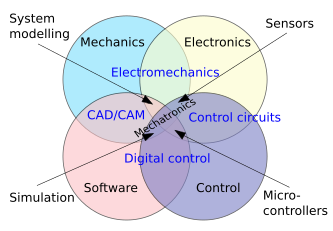Mechatronics: Difference between revisions
RegExTypoFix using AWB |
|||
| Line 32: | Line 32: | ||
*[http://www.realskillsrealjobs.com Mechatronics Education] at [http://www.sierracollege.edu Sierra College] |
*[http://www.realskillsrealjobs.com Mechatronics Education] at [http://www.sierracollege.edu Sierra College] |
||
*[http://www.mekatronikkulubu.org Mechatronics Education] at the [http://www.marmara.edu.tr University of Marmara] |
*[http://www.mekatronikkulubu.org Mechatronics Education] at the [http://www.marmara.edu.tr University of Marmara] |
||
*[http://www.eee.manchester.ac.uk/undergraduate/degreeprogrammes/mechatronicengineering/index.html] at the [[University of manchester]] |
|||
*[http://www.mechatronics.uwaterloo.ca Mechatronics Engineering] at the [[University of Waterloo]] |
*[http://www.mechatronics.uwaterloo.ca Mechatronics Engineering] at the [[University of Waterloo]] |
||
*[http://www.nyp.edu.sg/SEG/seg.html Mechatronics Education] at [http://en.wikipedia.org/wiki/Nanyang_Polytechnic nanyang polytechnic] |
*[http://www.nyp.edu.sg/SEG/seg.html Mechatronics Education] at [http://en.wikipedia.org/wiki/Nanyang_Polytechnic nanyang polytechnic] |
||
Revision as of 15:42, 7 August 2006
Mechatronics is the synergistic combination of mechanical engineering ("mecha" for mechanisms), electronic engineering ("tronics" for electronics), and software engineering. The purpose of this interdisciplinary engineering field is the study of automata from an engineering perspective and serves the purposes of controlling advanced hybrid systems.
Description

Mechatronics is centred on mechanics, electronics and computing which, combined, make possible the generation of simpler, more economical, reliable and versatile systems. The portmanteau "mechatronics" was first coined by Mr. Tetsuro Mori, a senior engineer of the Japanese company Yaskawa, in 1969. Mechatronics may alternatively be referred to as "electromechanical systems" or less often as "control and automation engineering".
Engineering cybernetics deals with the question of control engineering of mechatronic systems. It is used to control or regulate such a system; see control theory. A component-based paradigm is a form of distributed control production system which utilises a CAN or LAN to link autonomous mechatronic modules. Through collaboration the mechatronic modules perform the production goals and inherit flexible and agile manufacturing properties in the production scheme. Modern production equipment consists of mechatronic modules that are integrated according to a control architecture. The most known architectures involve hierarchy, polyarchy, heterarchy and hybrid. The methods for achieving a technical effect are described by control algorithms, which may or may not utilize formal methods in their design. Hybrid-systems important to Mechatronics include production systems, synergy-drives, planetary-rovers, automotive subsystems such as anti-lock braking systems, spin-assist and every day equipment such as autofocus cameras, video, hard disks, CD-players, washing machines, lego-matics etc.
A typical mechatronic engineering degree would involve classes in engineering mathematics, mechanics, machine component design, mechanical design, thermodynamics, circuits and systems, electronics and communications, control theory, digital signal processing, power engineering, robotics and usually a final year thesis.
Variant of this field
An emergent variant of this field is biomechatronics, whose purpose is to integrate machine and man, usually in the form of removable gadgets such as exoskeleton. This is the “real-life” version of cyberware. In fiction, the mad scientist's research occasionally involves this field.
See also
References
- Mechatronics Principles Concepts and Applications by Tata McGraw-Hill
- Bradley, Dawson et al, Mechatronics, Electronics in products and processes, Chapman and Hall Verlag, London, 1991.
- Karnopp, Dean C., Donald L. Margolis, Ronald C. Rosenberg, System Dynamics: Modeling and Simulation of Mechatronic Systems, 4th Edition, Wiley, 2006. ISBN 0471709654 Bestselling system dynamics book using bond graph approach.
External links
- Mechatronics at Rensselaer Polytechnic Institute
- Mechatronics Society of Bangladesh
- Mechatronics Education at University of Siegen, Germany
- Mechatronics Education at Asian Institute of Technology
- Mechatronics Education at Sabanci University
- Mechatronics Education at Sierra College
- Mechatronics Education at the University of Marmara
- [1] at the University of manchester
- Mechatronics Engineering at the University of Waterloo
- Mechatronics Education at nanyang polytechnic
- Mechatronics Engineering at the Unidad Profesional Interdisciplinaria en Ingeniería y Tecnologías Avanzadas
- Mechatronics Engineering at the Universidad Popular Autónoma del Estado de Puebla, UPAEP, Puebla, Mexico
- Mechatronics Engineering at the University of Canterbury
- Mechatronics Engineering Program at the Hamburg University of Technology TUHH
- Mechatronics Engineering at the University of British Columbia
- Master of Science Mechatronics at the University of Applied Sciences of Aachen
- Ingeniería Mecatrónica
- Mecatrónica Instituto Tecnológico de Querétaro
- DLR Institute of Robotics and Mechatronics
- University of Linz - Mechatronics
- Center for Automation and Intelligent Systems Research (CAISR) at Case Western Reserve University
- Advanced Intelligent Mechatronics conference 2005
- Faculty of Mechatronics Warsaw University of Technology
- ASME Mechatronics Online Course
- Australian Centre for Field Robotics (ACFR) at the University of Sydney
- Cal State, Chico
- KTB mechatronics, Germany
- Thesame mechatronics network (in french)
- Mechatronics Laboratory at EESC(Engineering School of São Carlos)- University of São Paulo - USP
- Precision MicroControl Corp. Intelligent Motion Control
- Mechatronics at the University of Western Australia
- Mechatronics Centre of Vocational Excellence at Tyne Metropolitan College, UK
